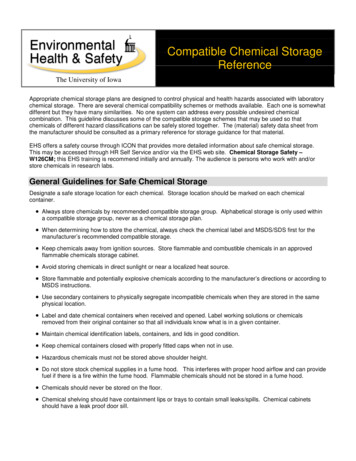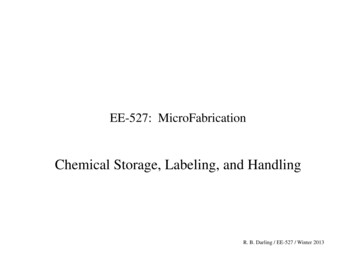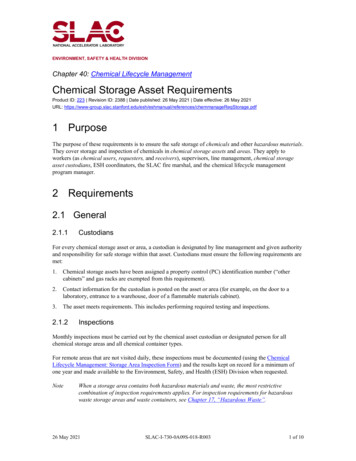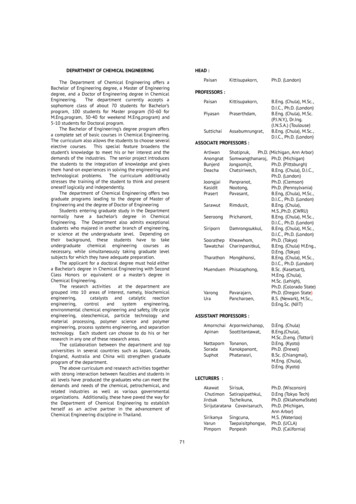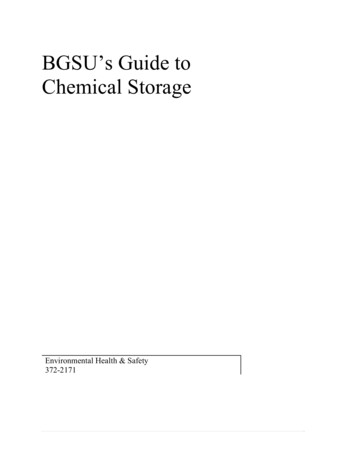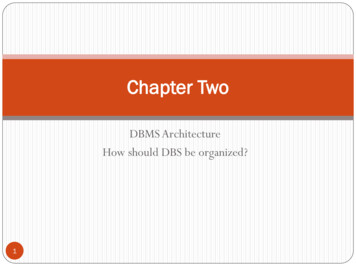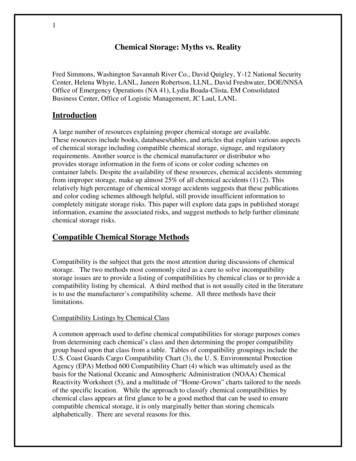
Transcription
1Chemical Storage: Myths vs. RealityFred Simmons, Washington Savannah River Co., David Quigley, Y-12 National SecurityCenter, Helena Whyte, LANL, Janeen Robertson, LLNL, David Freshwater, DOE/NNSAOffice of Emergency Operations (NA 41), Lydia Boada-Clista, EM ConsolidatedBusiness Center, Office of Logistic Management, JC Laul, LANLIntroductionA large number of resources explaining proper chemical storage are available.These resources include books, databases/tables, and articles that explain various aspectsof chemical storage including compatible chemical storage, signage, and regulatoryrequirements. Another source is the chemical manufacturer or distributor whoprovides storage information in the form of icons or color coding schemes oncontainer labels. Despite the availability of these resources, chemical accidents stemmingfrom improper storage, make up almost 25% of all chemical accidents (1) (2). Thisrelatively high percentage of chemical storage accidents suggests that these publicationsand color coding schemes although helpful, still provide insufficient information tocompletely mitigate storage risks. This paper will explore data gaps in published storageinformation, examine the associated risks, and suggest methods to help further eliminatechemical storage risks.Compatible Chemical Storage MethodsCompatibility is the subject that gets the most attention during discussions of chemicalstorage. The two methods most commonly cited as a cure to solve incompatibilitystorage issues are to provide a listing of compatibilities by chemical class or to provide acompatibility listing by chemical. A third method that is not usually cited in the literatureis to use the manufacturer’s compatibility scheme. All three methods have theirlimitations.Compatibility Listings by Chemical ClassA common approach used to define chemical compatibilities for storage purposes comesfrom determining each chemical’s class and then determining the proper compatibilitygroup based upon that class from a table. Tables of compatibility groupings include theU.S. Coast Guards Cargo Compatibility Chart (3), the U. S. Environmental ProtectionAgency (EPA) Method 600 Compatibility Chart (4) which was ultimately used as thebasis for the National Oceanic and Atmospheric Administration (NOAA) ChemicalReactivity Worksheet (5), and a multitude of “Home-Grown” charts tailored to the needsof the specific location. While the approach to classify chemical compatibilities bychemical class appears at first glance to be a good method that can be used to ensurecompatible chemical storage, it is only marginally better than storing chemicalsalphabetically. There are several reasons for this.
21) This method can create hazardous situations. Many chemicals belong to more thanone hazard class. This can lead to confusion as to which class is appropriate for thechemical in question. For example, nitric acid is both an acid and an oxidizer. If onestores it as an acid, then there is the potential that it will be stored with organic acids suchas acetic or formic acid, which, if mixed, can lead to a significant adverse reaction.Acetic acid is not only an acid, but is also a combustible liquid. Acetic anhydride isflammable, corrosive, and water reactive. Storing them with flammable liquids such asmethanol would not be a problem. It should be noted that some compatibility schemesstate that organic acids are incompatible with alcohols, but this is rarely the case. (4)2) Storage schemes based upon hazard classes are prone to failure because some hazardclasses are not listed. Sulfuric acid is a strong mineral acid, but it is also a strongdehydrating agent. Few, if any, classification schemes include dehydration as a chemicalclass and yet it can be significant. If one inadvertently mixed another strong acid such ashydrofluoric or hydrochloric acid with sulfuric acid, the sulfuric acid would immediatelydehydrate the hydrochloric or hydrofluoric acid. The result of this reaction would be alarge amount of heat generation and the immediate off gassing of either hydrogenchloride or hydrogen fluoride due to the removal of water as a solvent.3) Classification schemes do not work well because not all chemicals in a given class arecompatible. Sodium dichloroisocyanurate and calcium hypochlorite are both oxidizersand belong to no other class of chemical, yet the mixing of these two materials can leadto the formation of nitrogen trichloride, a shock sensitive explosive (National FireProtection Association (NFPA) 49, Hazardous Chemicals Data.(6)4) Classification schemes do not lend themselves toward consistent application betweenwork areas. If a worker spends part of his time in a work area where nitric acid is definedas an oxidizer and the rest of his time where nitric acid is classed as an inorganic acid,then the worker can become confused as to which storage practice is used in which area.Confusing storage schemes can lead to unsafe storage practices.5) Classification schemes are based upon chemical classes such as esters, aromaticamines, non-oxidizing mineral acids, etc. While this classification scheme may beinterpretable by a chemist, most workers are not chemists and would find theseclassifications confusing. Some classes such as non-oxidizing mineral acid could evenconfuse a chemist when the conditions present will determine whether an acid, such assulfuric acid, is an oxidizer or not. As confusion increases, so does the potential for amistake.Chemical Storage ListingsAnother method in use to ensure compatible chemical storage is to use compatibilitylistings or charts. These documents list various chemicals and those chemicals with
3which they are compatible. Some, such as the American Chemical Society (ACS)publication Safety in Academic Laboratories (7), are fairly short, while others are moreextensive. The primary difficulty with using these lists/charts is that they are limited.None provide information for every chemical or chemical product and, many times, someincompatible interactions are not noted. If one were to rely upon one of these charts, thenit might provide a false sense of security if one assumes the listing is comprehensive.Another difficulty with these charts is that one does not always know the type ofinteraction or the conditions being described which cause the mixture to be incompatiblenor is the applicability always apparent. For example, solutions of analytical reagentsmade up in dilute acids and bases may not represent a significant issue even though thelisting indicates that it is incompatible. A last issue concerning the difficulty in usingthese lists is that their use requires a certain amount of expertise and different users willhave differing opinions as to how the listings should be applied. Variations in expertiseor differences in opinion can lead to inconsistent applications of the storage scheme,which could become a problem if workers move from one work location to another.Manufacturer’s Storage SchemesBlindly using manufacturer’s schemes can also lead to incompatible storage situations orstorage situations that potentially violate regulations. Two well known manufacturer’s ordistributors of chemicals have similar color coded storage schemes. In both schemes, thecolor red is used to denote flammable storage, white is used to denote acid storage andyellow is used to denote oxidizer storage. If one looks at how various acids are classifiedaccording to these two schemes, one can immediately see numerous issues (Table 1).Manufacturer 1ChemicalCompatibility CodeHydrofluoric AcidWhiteSulfuric AcidWhiteHydrochloric AcidWhitePhosphoric AcidWhiteOxalic AcidWhiteFormic AcidWhiteAcetic AcidRedNitric AcidYellowPerchloric AcidYellowManufacturer 2ChemicalCompatibility CodeHydrofluoric AcidWhiteSulfuric AcidWhiteHydrochloric AcidWhitePhosphoric AcidWhiteOxalic AcidWhiteFormic AcidWhiteAcetic AcidRedNitric AcidWhitePerchloric AcidWhiteTable 1. Storage classification of acids using two similar manufacturer’s storageschemes.1) Incompatibilities exist within each storage scheme. Both manufacturers indicate thatsulfuric acid can be stored compatibly with hydrochloric acid or hydrofluoric acid whichhas been shown not to be the case (see (2) above). Additionally, Manufacturer 2incorrectly indicates that the oxiding nitric and perchloric acids are compatible with theorganic formic and oxalic acids. Both manufacturers recommended acetic acid be stored
4as a flammable liquid while neither recommended it for formic acid. Both formic andacetic acids are classified as combustible liquids. This may require them to be stored inflammable liquids storage cabinets depending on the quantity of material on-hand and thelimits imposed on the facility by codes or standards.2) The two systems appear to be similar, but it would take a well trained individual torealize that they are different and what those differences are. If no compatibility schemeexists or the user is relying upon the manufacturer to provide the compatibilityinformation on each chemical container, then using chemicals from more than onemanufacturer could lead to incompatible chemical storage as the worker gets the variousschemes confused.3) Most locations do not limit the chemicals present to those offered or classified by onemanufacturer. If no other compatibility scheme exists, then how does one store achemical that is not classified by the manufacturer?4) Manufacturer’s compatibility schemes are not designed to address regulations whichset facility limits on the quantity of specific chemicals that may be stored. For example,OSHA in 29CFR 1910.106 “Flammable and combustible liquids” or locally enforced firecodes such as NFPA 1 “Uniform Fire Code” limit how much of a flammable orcombustible liquid may be stored in various locations such as outside of a flammableliquids storage cabinet. Storing organic acids that are not identified as being a flammableor combustible liquid could cause one to become noncompliant with flammable andcombustible liquids storage requirements.Other Chemical Storage ConsiderationsStorage areas are rarely discussed to any depth in chemical safety references. When theyare discussed, topics such as provisions for bonding and grounding of flammable liquids,separation distances, storage unit (i.e. shelves or cabinet) types, or ventilation are usuallycovered. Several other important issues are rarely covered.CompatibilityWhen discussing compatibility the issue is usually exclusively limited to compatibilitiesbetween chemicals being stored. What is just as important is the issue of compatibility ofchemicals being stored with their environment. Examples of improper storage conditionswould include: Storage of oxidizers on unpainted wooden, shelves is prohibited (for example,NFPA 432 Code for the Storage of Organic Peroxide Formulations, 2002 Edition(8) also prohibits the storage of hydrogen peroxide [concentrations greater than27.5%] on wooden pallets since oxidizer impregnated wood is prone tospontaneous combustion) (see Figure 1). Chemicals should not be stored above face level due to the potential of spillsfalling into a person’s face (see Figure 2).
5 Storage of water reactive chemicals in a facility with a water-based firesuppression system (due to potentially adverse chemical reactions during a fireresponse),Corrosives stored on unpainted shelves (since corrosion which can weakenshelves or hydrogen gas generation can occur) (see Figure 3) ,Acid storage in rooms with unpainted cement floors and/or cement or concreteblock walls (due to the reaction between acids and cement), andOxidizers cannot be stored where they will come into contact with heating units,piping or ducts (since some oxidizers will violently decompose upon heating).Figure 1. (photo by Ken Niswonger, Chief Chemist Hazardous Materials Division,Colorado Department of Public Health and Environment) Storage of chemicals onwooden shelves. Are any chemicals stored here oxidizers? Note the flammable liquidloading on the right. This shelving arrangement would not last should a fire occur evenwith fire sprinkler activation.
6Figure 2. (photo by Ken Niswonger) Chemicals stored above face level. Manychemicals are stored above face level have the potential for spilling into a worker’s faceduring their removal or placement on the shelf. Some chemicals shown on the uppershelves have ground glass or cork stoppers. One should note the good practice of havinga lip on chemical storage shelves to protect from containers falling off from vibrationsdue to seismic activity, road traffic, building work, etc.
7Figure 3. (photos by Ken Niswonger) Storage of Acids in Cabinets. Perchloric acidstored in a cabinet designed for acids (left) shows no corrosion while perchloric acidstored in a metal cabinet (right) shows extensive corrosion even when stored in a plasticsecondary container and the metal is painted. Note the cracked cap on the container(right).MaintenanceAnother issue that is rarely discussed is the need to control those activities performed in astorage area. Because chemical storage areas are inherently unsafe, all activities to beperformed there must be reviewed for safety. This means that activities such asmaintenance, building modifications, etc., must all be carefully controlled and reviewedto ensure that these activities can be performed safely.Chemical Storage RequirementsThere are many requirements that regulate the storage of chemicals. These requirementsmay come from federal or local governments or may be from consensus standards such asthose from the NFPA and the Compressed Gas Association (CGA) (9-15). Theserequirements are continuously evolving. For example, the recently revised NFPA 55,Standard for the Storage, Use, and Handling of Compressed Gases and Cryogenic Fluidsin Portable and Stationary Containers, Cylinders, and Tanks 2003 Edition (10), greatlyexpanded its scope by including extensive requirements for cryogenic liquids.Compatible Chemical StorageOccasionally, one will hear an argument about how compatible chemical storage is agood idea, but can be taken too far. An example of this argument is how some solidoxidizers, such as nitrates, do not need to be segregated from organics. The argument isthat a reaction between nitrates and solid organics will not occur under any condition andthat requiring their segregation during storage is not justified (16). While this may betrue from a technical point of view, fire codes, building codes, and various NFPAstandards require their segregation.
8Facility LimitsLocally enforced fire/building code requires facilities to limit the amount of hazardousmaterial stored there. To meet this requirement each facility must classify each chemicalaccording to their hazards. Examples of hazards include class 1, 2, 3 and 4 oxidizer;toxic; highly toxic, pyrophoric gas; etc. There are approximately forty hazardclassifications and a chemical is likely to be classified as having more than one hazard.Fire code limits how many pounds of a liquid or solid and cubic feet of a gas of a givenhazard classification can be stored in a facility. If these limits are exceeded then the localauthority having jurisdiction may suspend the facility’s occupancy permit until limits areattained. If quantities greater that those listed need to be stored, then specializedstructures meeting various building and fire codes can be constructed for that purpose.SecuritySecurity should be a priority for all chemical storage areas. Security is required and isessential for many reasons.First, basic chemical inventory and management principles require secured storage. Iffree access to chemical storage areas is allowed, then users will wander in and out withchemicals and the ability to track and keep an accurate inventory will be lost or mademuch more difficult. Controls can be put in place to monitor when users removechemicals, but this can incorporate uncertainty into the chemical management process.Second, unrestrained access to chemical storage areas can endanger the quality ofchemical storage. If personnel are allowed to remove chemicals from a common storagearea such as a stockroom and then return them after use, then a question of productquality arises. Incorrect dispensing techniques can result in contaminated or impurechemicals and future users may not want to risk using impure chemicals that couldnegatively affect their work. This results in opened chemicals accumulating in thestorage as fewer users will risk using them. Eventually, these accumulated chemicalsmust be removed as costly unused/unspent waste.Third, unrestricted access can result in people placing chemicals in the store room in thewrong, incompatible location, which can increase the danger of an accident in thechemical storage area. Lastly, chemicals represent feedstocks or source materials forillegal activities such as illicit drug manufacturing, bomb making, etc. Unrestrictedaccess can result in pilferage and increased liability. Finally, there are some chemicalswhich may require increased scrutiny due to other reasons such as being on the DrugEnforcement Administration (DEA) watch list (17) for chemicals used in illegal drugmanufacturing.
9Time-Sensitive Storage:Some chemical products are sensitive to the length of time they are stored. One reason achemical may be time-sensitive is safety. Some chemicals can generate additionalhazards such as the formation of explosive peroxides (e.g., ethers) or toxic gases (e.g.,chloroform), while others develop explosion from the evaporation of water (e.g., picricacid) or the generation of gases (e.g., anhydrous HF) (18). These chemicals must beidentified and properly managed.Another reason why chemicals may be sensitive to the length of time they are stored isquality. Some products deteriorate over time which affects their quality and their abilityto perform a task.SignageSignage is an integral part of chemical storage. Signage serves to notify emergencyresponders and visitors, as well as remind employees of the hazards associated with aparticular location. For example, there are specific signage requirements for CompressedGases (9, 10), No Smoking signs (11 -13), Oxidizers (8), and Flammables (15), as well asthose for the NFPA 704 placard.RecommendationsIs there a cookbook for chemical storage? The answer is no. Safe chemical storagecannot be reduced to a list or chart. Proper chemical storage should not exist as a list orchart, but should be a process consisting of several major steps that are designed for thesize and complexity of the inventory. These steps are:Step 1: Classify All Chemical Products PresentThe first step is to classify all chemical products present. Classification comes in twoforms. The first is the initial classification of the initial or existing inventory. As thesize of the existing inventory increases, the size and expense of this task increases. Thesecond form is the ongoing classification of new or incoming products. It is imperativethat new or incoming chemicals are classified prior to their arrival at the facility. Thisgenerally requires a pre-review process to be performed to determine the compatibilityclassification, but this pre-review process must be timely and not hold up theprocurement of the product.In performing these compatibility classifications it is very important to obtain the help ofa knowledgeable chemist to classify chemicals in the scheme for several reasons. Onereason to obtain the help of a knowledgeable chemist to help classify chemicalsaccording to the compatibility scheme is that many chemicals can fall into multiplehazard or compatibility groupings. For example, nitric acid could be classified as anacid, corrosive, or an oxidizer; acetic acid could be classified as a flammable/combustibleliquid, acid, or corrosive; benzoyl chloride could be classified as a combustible liquid,
10water reactive, unstable (reactive), corrosive, or lachrymator; and acrolein could beclassified as a flammable liquid, unstable (reactive), highly toxic, sensitizer, or timesensitive (peroxide former). Determining which class is the most significant is notalways easy. While approximately 90% of all chemicals will be simple to classify, theremaining 10% can fall into multiple classification groups and it is important to ensurethat these chemicals are correctly classified. What can complicate this determination isthe need to look at other chemical classed in a given grouping and ensuring that any newchemical classed in that group does not cause an incompatibility issue to arise.Another reason to obtain the help of a knowledgeable chemist is that not all chemicals ina given class can be stored together. For example a common pool chemical, sodiumdichloroisocyanurate, is an oxidizer, but cannot be mixed with chlorine based oxidizers.If these are mixed, then the explosively unstable nitrogen trichloride is formed. Few,other than a knowledgeable chemist, would be cognizant of this or other incompatiblemixtures.A third reason to obtain the help of a knowledgeable chemist is that the regulationssometimes appear to be contradictory. Someone needs to understand the intent behindthe regulation to divine what the regulation is attempting to accomplish in light of thechemistry of the products being managed or stored. An example is the prohibition ofstoring acids and bases together. While this is a good practice, it is not practical whenone has numerous atomic absorption standards made up in dilute nitric acid and a fewmade up in dilute ammonium hydroxide. Clearly, mixing these acid and base solutionswill not result in a hazardous reaction and forcing workers to store such standardsseparately is inconvenient and unnecessary.Step 2: Determine the Proper Storage AreaWhile finding a proper storage area is a task that becomes more complex as the size ofthe chemical inventory increases, the basic principles remain the same. Someconsiderations to be aware of when determining a proper storage area are:SizeOne principle is to ensure that the storage area is large enough. For small inventories thisis a simple task, but this task becomes more difficult as the inventory size increasesespecially for facilities where space comes at a premium. To determine the proper size ofthe storage area, one must have some idea of both the classes of chemicals one is to storeand the volume of each. One must also be knowledgeable of the locally enforcedbuilding and fire codes. First, each chemical must be classified according to building/firecode hazard definitions and then the estimated quantity of each hazard class compared tolocally enforced fire/building code limits. When the quantity of a given hazard is over alimit specified in the building/fire code, then either the quantity must be reduced or aspecialized facility must be found or constructed. Second, segregation distances andprinciples must be obeyed. Some chemical classes must be segregated from other
11chemical classes by either a specific distance or by structural barriers such as berms orfire walls. Once again, knowledge of fire/building code will be required for complaintstorage practices. Third, sufficient area should be allowed so that chemical storage is notcramped. Cramped storage leads to unsafe practices such as storing chemicals above facelevel (especially toxics or corrosives), overloading shelves making it difficult to inspectchemical containers or obtain containers from the back of shelves, storing chemicals onthe floors in aisles, stacking chemical containers on each other, etc.CompatibilityWhen the issue of chemical compatibility comes up, most think that this issue refers toone chemical being compatible with another. While this is an important issue inchemical storage, it is equally important to ensure that each chemical is compatible withthe storage area itself. Chemicals for which this is particularly important are those thatare reactive such as acids, bases, oxidizers, water reactives, etc. Typical mistakes that aremade and their solutions are listed in Table 1.Chemical ClassOxidizersUnstable (Reactive),Oxidizer,Compressed GasesWater ReactiveAcids, BasesOrganic PeroxidesIncorrect Storage PracticeStored on wooden shelveswhich can absorb spilledproduct.Stored near heatingvents/pipes, in directsunlight, or other sources ofheating.Stored in the open in an areacovered by a water based firesuppression system(sprinklers).Stored on metal shelves thateither have exposed metal orwhere the paint is easilyscratched to expose baremetal.Stored on shelves with notemperature control.Correct Storage PracticeStore on wood coated with animpregnable material such asepoxy paint.Store in cool dry area out of directsunlight.Store in plainly marked cabinetsthat meet code requirements.Store on shelves that are chemicaland abrasion resistant such asepoxy painted, wooden shelves.Store in area such as a refrigeratorwhere the temperature will remainbelow the self acceleratingdecomposition temperature(locally enforced building/firecodes should be checked fortemperature control and alarmrequirements).Table 2. Typical mistakes made and solutions in determining proper chemical storageareas.
12Some compatibility issues are straight forward. For example, if oxidizers are stored onwooden shelves then the wood can absorb spilled oxidizer especially if the oxidizer is ina liquid form. Absorbed oxidizer can then react with the wood to cause a fire orexplosion when subjected to compression or shock that could come from placing acontainer on the spill area. Another example of an obvious compatibility issue concernsthe storage of acids or bases on metal shelves. Acids or bases can react with the metal toform hydrogen gas or can corrode the shelf and weaken it. Other compatibility issues areless straight forward. Most do not consider sources of heat when determining a storagearea, but heat can cause compressed gas cylinders to overheat and fail, or can cause someoxidizers, organic peroxides, or unstable (reactive) chemicals to undergo an energeticthermal decomposition reaction. Another issue that is commonly overlooked is thestorage of water reactive products in a sprinklered area. This practice can causesignificant issues during a fire when the sprinklers are activated and containers of waterreactive materials could be broken during the response.Also consider the compatibility of the chemicals with other containers around it.Hexadimethylsilazane is incompatible with steel. If a chemical of the same class isstored in a steel can, the steel can will corrode.Figure 4 Steel containers incompatible with surrounding chemicals.VentilationSome chemical hazard classes such as flammable liquids require special ventilation whenprescribed limits are reached. These requirements include a minimum of one cubic footof air per minute per square foot floor space and air returns located near the floor. Whilethere are no formal requirements, proper ventilation can eliminate or reduce hazards andpotential difficulties. Having adequate ventilation can reduce or eliminate many of the
13odors associated with chemical storage areas and makes it a more comfortable place towork. Some chemicals should be stored in a room that is at a slightly negative pressureto the rest of the facility with the exhaust being directly vented to the outside. Chemicalsin this group would be those with high vapor pressures that can react. This would includeacids such hydrochloric acid and bases such as ammonium hydroxide. Vapors from thesecan react to form ammonium chloride which will cover all surfaces including glass with awhite film. This white film can make it difficult to see through the glass on a cabinetdoor to determine the cabinet’s contents. Other types of chemicals that could be stored inthis type of room would be those that are a stench hazard (e.g., putrescine, cadavarine),lachrymators (e.g., benzoyl chloride), or toxic with a high vapor pressure (e.g.,formaldehyde).Other IssuesNumerous other issues should be taken into account when looking for a proper chemicalstorage area. Shelves used for chemical storage should be braced and anchored toprevent their tipping over. Shelves should also be of a substantial construction and havea lip or other means present to prevent chemicals from falling off the shelf. Aisles shouldtypically be a minimum of four feet wide and appropriate illumination should befollowed. Floors of storage areas should be made of a noncombustible material andprovisions should be available for secondary containment should a spill occur. Locationsand room for storage cabinets should be factored into the determination of a chemicalstorage area. Storage cabinets that might be required include flammable liquids storagecabinets, gas cabinets, and acid cabinets. Likewise, the need and room for gloveboxes,refrigerators and freezers should also be considered. Regulations should be researched todetermine what signs need to be posted to alert both every day users and emergencyresponders and access requirements for the storage area determined. Lastly, the allowingof chemical dispensing in the storage area should be considered. Allowing chemicaldispensing could result in additional requirements such as bonding and grounding,specialized ventilation, etc. A fire protection engineer should be consulted to determinethese additional requirements.Step 3: Determine a Chemical Compatibility SchemeThe complexity of determining a chemical compatibility scheme is dependent upon thesize of the inventory. Small inventories are the easiest and complexity increases as theinventory increases. Small simple inventories are not likely to contain significant numberof products that require special concern. For these inventories, one can simply adopt thelabeling scheme present on the manufacturer’s label if one is present. This will workwell if one procures all chemical products from the one manufacturer
OSHA in 29CFR 1910.106 "Flammable and combustible liquids" or locally enforced fire codes such as NFPA 1 "Uniform Fire Code" limit how much of a flammable or combustible liquid may be stored in various locations such as outside of a flammable liquids storage cabinet. Storing organic acids that are not identified as being a flammable


